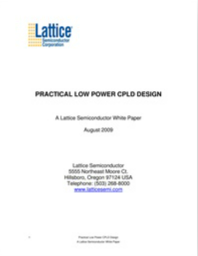PRACTICAL LOW POWER CPLD DESIGN
Any engineer involved with portable or handheld products knows that minimizing power consumption is an absolute requirement for today's designs. But only the veterans understand the subtle yet important details that can stretch a systems' battery life to the maximum.
In this white paper Lattice Semiconductor focusses on how those seasoned experts use ultra-low-power complex programmable logic devices (CPLDs) to wring out every last microwatt from the I/O subsystems of their embedded designs.
Download to find out more.
Read More
By submitting this form you agree to Lattice Semiconductor Corporation contacting you with marketing-related emails or by telephone. You may unsubscribe at any time. Lattice Semiconductor Corporation web sites and communications are subject to their Privacy Notice.
By requesting this resource you agree to our terms of use. All data is protected by our Privacy Notice. If you have any further questions please email dataprotection@techpublishhub.com
Related Categories: Batteries, Components, Displays, Embedded, Industrial, Power, Processors, Relays, Resistors, Switches

More resources from Lattice Semiconductor Corporation
POWER CONSIDERATIONS IN FPGA DESIGN
Power has always been a design consideration. Traditionally, though, a lower priority has been assigned to power than to most other variables (spee...
Intellegently Expanding Microprocessor Connectivity Using Low-cost FPGAs
Whether they be CPUs, micromicroprocessors or microcontrollers, microprocessors are an indispensable component in modern electronic system design. ...
2:1 MIPI CSI-2 Bridge Soft IP
In some cases, mobile Application Processors (AP) may not have enough interfaces to support the number of image sensor inputs required for a partic...
